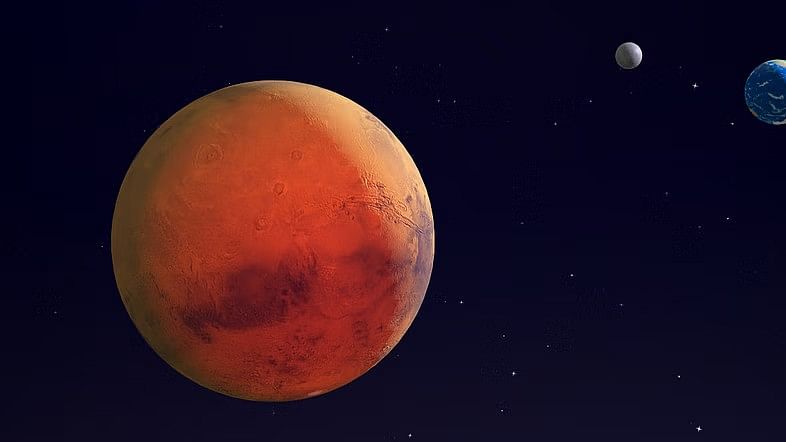
Representative Image showing Mars.
Credit: iStock Photo
A news study by the National Aeronautics and Space Administration (NASA) has found that life on Mars is possible as there is potential for photosynthesis within snow and ice on the Martian surface.
The study, published in the Nature journal takes the help of radiative transfer modelling and shows that the amount of sunlight able to pass through the ice is enough for microbes to carry out the process of photosynthesis in shallow pools of meltwater below the surface of that ice.
According to the study, due the presence of Ozone layer on the Earth, the harmful ultraviolet rays from the Sun are reflected back while the organisms within ice can harness and use the energy from photosynthetically active radiation.
Meanwhile, on Mars, the lack of an effective ozone shield allows approximately 30 per cent more damaging ultraviolet radiation to reach the surface in comparison with Earth.
Authors of the study, Aditya R Khuller, Stephen G Warren, Philip R Christensen and Gary D Clow have found that there are radiatively habitable zones within exposed mid-latitude ice on Mars, at depths ranging from a few centimetres for ice with 0.01–0.1 per cent dust, and up to a few metres within cleaner ice.
The research was conducted by examining water ice, which is a mixture of snow and dust, formed during the Martian ice ages.
"To investigate whether radiatively habitable zones exist within mid-latitude ice exposures on Mars, we have developed a radiative transfer model for ice, based on work validated previously using measurements of snow, as well as snow that has metamorphosed into coarser-grained firn and glacier ice on Earth and Mars," the paper said.
The study further concludes that despite higher surface ultraviolet radiation levels on Mars than on Earth, it is possible for terrestrial photosynthetic organisms to find locations within exposed ice on Mars with favourable solar radiative conditions.
If exposures of these dusty mid-latitude martian ice melt below the surface for a fraction of the year as predicted by numerical models, then, like on Earth, microbes such as cyanobacteria could scavenge nutrients from the dust mixed in with the ice, and utilize the small amounts of melt whilst being in a radiatively favourable habitat below the surface, the study adds.
The research paper also leaves way for future robotic and human missions to Mars to find extant life at these potential present-day habitats.